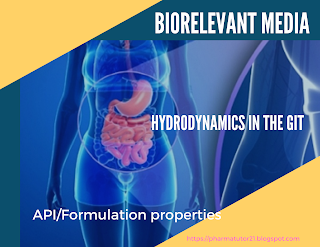Biorelevant Media l Hydrodynamics in the GIT l API/Formulation properties
Biorelevant Media l Hydrodynamics
in the GIT l API/Formulation
properties
How a medicine
should be taken is usually explained in the patient information leaflet
provided by the manufacturer. Whether a drug is taken before or after a meal
can have a big impact on its absorption because food changes the properties of
gastrointestinal fluids a lot. Gut fluids in both fasted and fed states are
simulated by Biorelevant Media.
I have already shared the information regarding Fluid
composition in the GIT. More details refer link
https://pharmatutor21.blogspot.com/2021/01/biorelevant-dissolution-media.html
This blog will help you to understand other two steps i.e. Hydrodynamics
in the GIT and API/formulation properties
Biorelevant dissolution medium
Before the development of biorelevant dissolution medium the
following steps should be considered
1) Fluid composition in the GIT
2) Hydrodynamics in
the GIT
3) API/formulation
properties
4) Prediction of plasma profile
5) Development of IVIVCs
2) Hydrodynamics:
The dissolution fluid
flow characteristics should consist of a predictable pattern that is free of
irregularities or variable turbulence. Hydrodynamics is predominant for the
overall dissolution rate if the mass transfer process is mainly controlled by
convection/diffusion as is usually the case for poorly soluble substances. A
thorough knowledge of hydrodynamics is useful in the course of dissolution
method development and formulation development for pharmaceutical industries
quality needs. The dissolution apparatus used for different formulation are
shown in Table 1.
Table 1: Apparatus used for different formulation
|
Types of dosage
form |
Release method |
|
Solid oral dosage form |
Basket, paddle, reciprocating
cylinder |
|
Implants |
Modified flow through cell |
|
Chewing gum |
Special apparatus |
|
Powders & granules |
Flow through cell |
For more details about the dissolution apparatus used for different formulation refer the link
https://pharmatutor21.blogspot.com/2021/01/different-dissolution-testing-apparatus.html
Muscular contraction
in the wall of the small intestine achieve two objectives one is stirring of
the contents to increase exposure to enzymes and to bring the luminaly digested
products close to the wall and second propulsion of indigestible material
towards the distal gut.
3) API/Formulation characteristics
Knowledge of the physiochemical
nature of a compound in biorelevant media is useful for formulation
development, which follows API phase selection. Based on this information the
pKa profile of compound could be improved by modifying the surfactants or
excipients in the formulation. Many new chemical entities possess
physiochemical characteristics unfavorable for oral absorption.
· BCS:
A biopharmaceutical
classification system is a scientific framework for classifying the drug
substance based on their aqueous solubility and intestinal permeability. The
BCS was first devised in 1995, by Amidon et al and since then it has become a
benchmark in the regulation of bioequivalence of oral drug products. According
to BCS classification drugs can be categorized as follows
Class 1: High
solubility and high permeability
Class 2: Low
solubility and high permeability
Class 3: High
solubility and low permeability
Class 4: Low
solubility and low permeability
For drugs belonging
to class 1 and 3, simple aqueous media such as SGF and SIF (with or without
enzymes) are suggested. In contrast for class 2 and 4 use of biorelevant media
is recommended for dissolution testing. There are various methods of
determination of solubility and permeability.
For more details of
BCS classification, refer link
https://pharmatutor21.blogspot.com/2021/01/the-biopharmaceutics-classification.html
· Solubility:
Solubility is a
crucial parameter for successful drug development as poor solubility
compromises the Pharmacokinetic and Pharmacodynamic properties of drug. Drug
solubility testing in biorelevant media has become an indispensable tool in
pharmaceutical development.
Solubility can be
measured either thermodynamically or kinetically.
Ø Thermodynamic
solubility can be defined as the concentration in solution of a compound
in equilibrium with an excess of solid material at the end of the dissolution
process and often considered as true solubility.
Ø Kinetic solubility considers the
precipitation after dilution in a suitable solution of a compound predissolved
in a co-solvent or in aqueous media by pH adjustment for ionizable compound.
Solubility of drug in
biorelevant dissolution media increased compared to the solubility in aqueous
buffer because of enhanced wetting and micellar Solubilization.
· Particle Size:
The dissolution rate
is directly proportional to the surface area of the drug. Reducing particle
size leads to an increase in the surface area exposed to the dissolution
medium, resulting in a greater dissolution rate. Thus, the dissolution rate of
poorly soluble drugs can often be enhanced markedly by undergoing size
reduction (e.g., through micronization).
Particle size
reduction does not always improve the dissolution rate. This is in part
attributed to adsorption of air on the surface of hydrophobic drugs, which
inhibits the wetting and hence reduces the effective surface area. In addition,
fine particles tend to agglomerate in order to minimize the surface energy,
which also leads to a decrease in the effective surface area for dissolution.
· Drug pKa and gastrointestinal pH:
The amount of drug
that exists in unionized form is a function of dissociation constant (pKa) of
the drug and pH of the fluid at absorption sites. The relation between drug pKa
and ionization and absorption is shown in Table 2.
Table 2: Relation between drug pKa and ionization
|
S.No |
pKa
range & drug nature |
pH/site
of absorption |
|
1 |
Stronger acid (pKa< 2.5) |
Ionized
at all pH values; Poorly absorbed from GIT. |
|
2 |
Moderately weak acid (pKa= 2.5- 7.5) |
Unionized in gastric pH values and ionized in intestinal; better
absorbed from stomach. |
|
3 |
Very weak acid (pKa >8) |
Unionized
at all pH values; absorbed along the entire length of GIT. |
|
4 |
Stronger base (pKa>
11) |
Ionized all pH values;
Poorly absorbed from GIT. |
|
5 |
Moderately weak base (pKa= 5-11) |
Ionized
at gastric pH; relatively unionized at intestinal pH; better absorbed from
intestine. |




Comments
Post a Comment